Influence of Peer Communication on Adolescents' Attitude towards Social Advertisements
VerifiedAdded on 2023/04/05
|7
|1576
|162
AI Summary
This article examines the influence of peer communication on adolescents' attitude towards social advertisements on social networking sites (SNSs). It explores how engagement in online peer interaction alters attitude and persuasive knowledge towards the corresponding ad. The study provides insights into the relationship between online peer communication and interpretation of social advertising on an SNS.
Contribute Materials
Your contribution can guide someone’s learning journey. Share your
documents today.
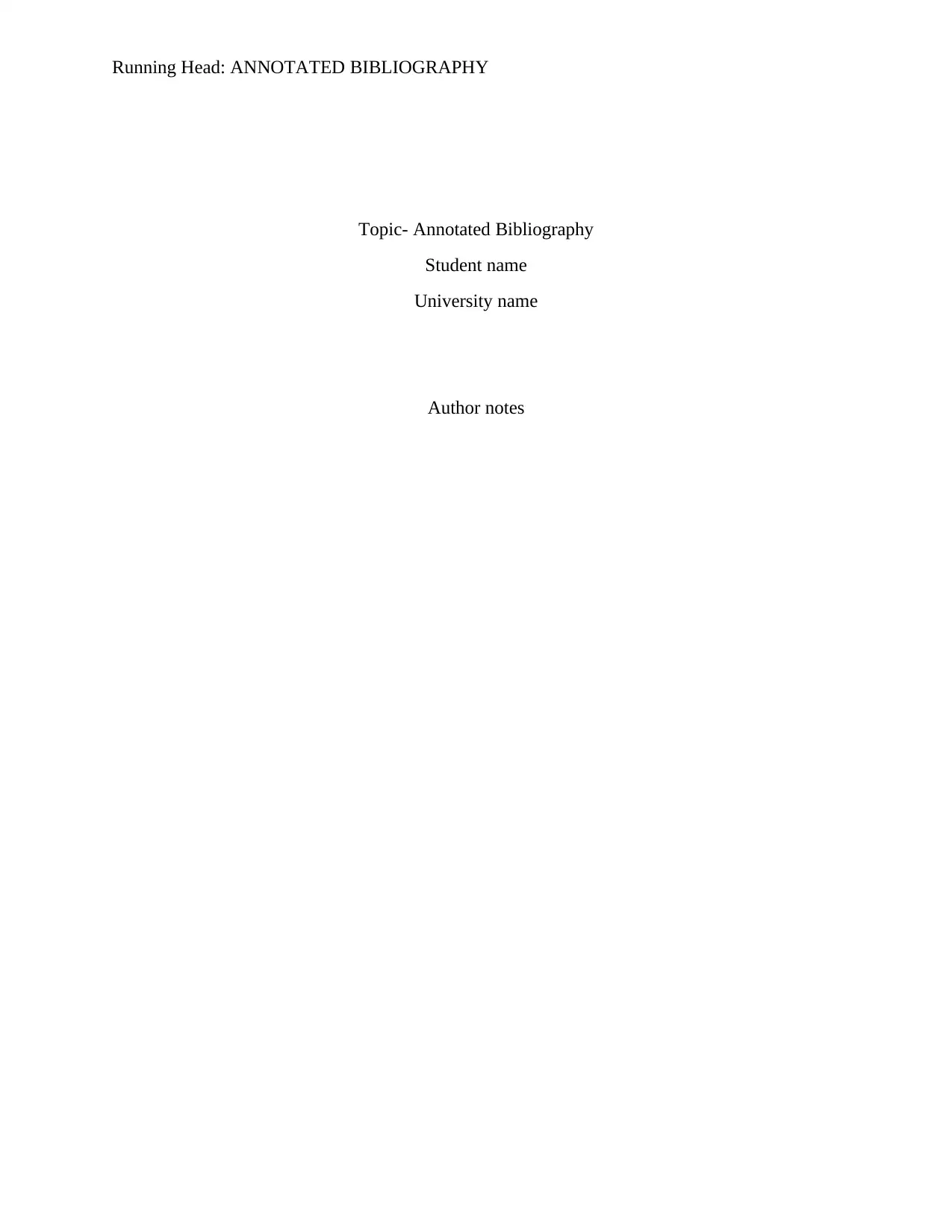
Running Head: ANNOTATED BIBLIOGRAPHY
Topic- Annotated Bibliography
Student name
University name
Author notes
Topic- Annotated Bibliography
Student name
University name
Author notes
Secure Best Marks with AI Grader
Need help grading? Try our AI Grader for instant feedback on your assignments.
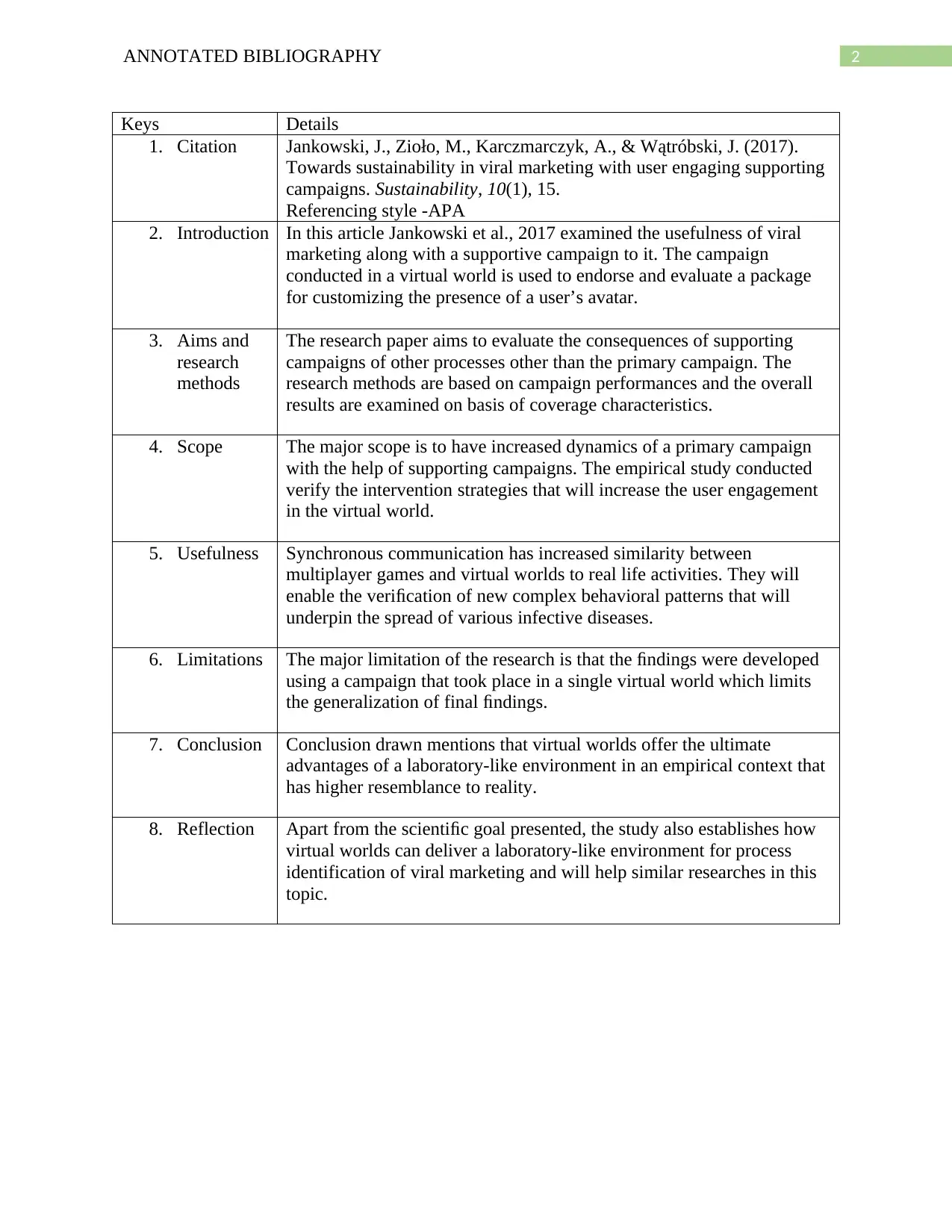
2ANNOTATED BIBLIOGRAPHY
Keys Details
1. Citation Jankowski, J., Zioło, M., Karczmarczyk, A., & Wątróbski, J. (2017).
Towards sustainability in viral marketing with user engaging supporting
campaigns. Sustainability, 10(1), 15.
Referencing style -APA
2. Introduction In this article Jankowski et al., 2017 examined the usefulness of viral
marketing along with a supportive campaign to it. The campaign
conducted in a virtual world is used to endorse and evaluate a package
for customizing the presence of a user’s avatar.
3. Aims and
research
methods
The research paper aims to evaluate the consequences of supporting
campaigns of other processes other than the primary campaign. The
research methods are based on campaign performances and the overall
results are examined on basis of coverage characteristics.
4. Scope The major scope is to have increased dynamics of a primary campaign
with the help of supporting campaigns. The empirical study conducted
verify the intervention strategies that will increase the user engagement
in the virtual world.
5. Usefulness Synchronous communication has increased similarity between
multiplayer games and virtual worlds to real life activities. They will
enable the verification of new complex behavioral patterns that will
underpin the spread of various infective diseases.
6. Limitations The major limitation of the research is that the findings were developed
using a campaign that took place in a single virtual world which limits
the generalization of final findings.
7. Conclusion Conclusion drawn mentions that virtual worlds offer the ultimate
advantages of a laboratory-like environment in an empirical context that
has higher resemblance to reality.
8. Reflection Apart from the scientific goal presented, the study also establishes how
virtual worlds can deliver a laboratory-like environment for process
identification of viral marketing and will help similar researches in this
topic.
Keys Details
1. Citation Jankowski, J., Zioło, M., Karczmarczyk, A., & Wątróbski, J. (2017).
Towards sustainability in viral marketing with user engaging supporting
campaigns. Sustainability, 10(1), 15.
Referencing style -APA
2. Introduction In this article Jankowski et al., 2017 examined the usefulness of viral
marketing along with a supportive campaign to it. The campaign
conducted in a virtual world is used to endorse and evaluate a package
for customizing the presence of a user’s avatar.
3. Aims and
research
methods
The research paper aims to evaluate the consequences of supporting
campaigns of other processes other than the primary campaign. The
research methods are based on campaign performances and the overall
results are examined on basis of coverage characteristics.
4. Scope The major scope is to have increased dynamics of a primary campaign
with the help of supporting campaigns. The empirical study conducted
verify the intervention strategies that will increase the user engagement
in the virtual world.
5. Usefulness Synchronous communication has increased similarity between
multiplayer games and virtual worlds to real life activities. They will
enable the verification of new complex behavioral patterns that will
underpin the spread of various infective diseases.
6. Limitations The major limitation of the research is that the findings were developed
using a campaign that took place in a single virtual world which limits
the generalization of final findings.
7. Conclusion Conclusion drawn mentions that virtual worlds offer the ultimate
advantages of a laboratory-like environment in an empirical context that
has higher resemblance to reality.
8. Reflection Apart from the scientific goal presented, the study also establishes how
virtual worlds can deliver a laboratory-like environment for process
identification of viral marketing and will help similar researches in this
topic.
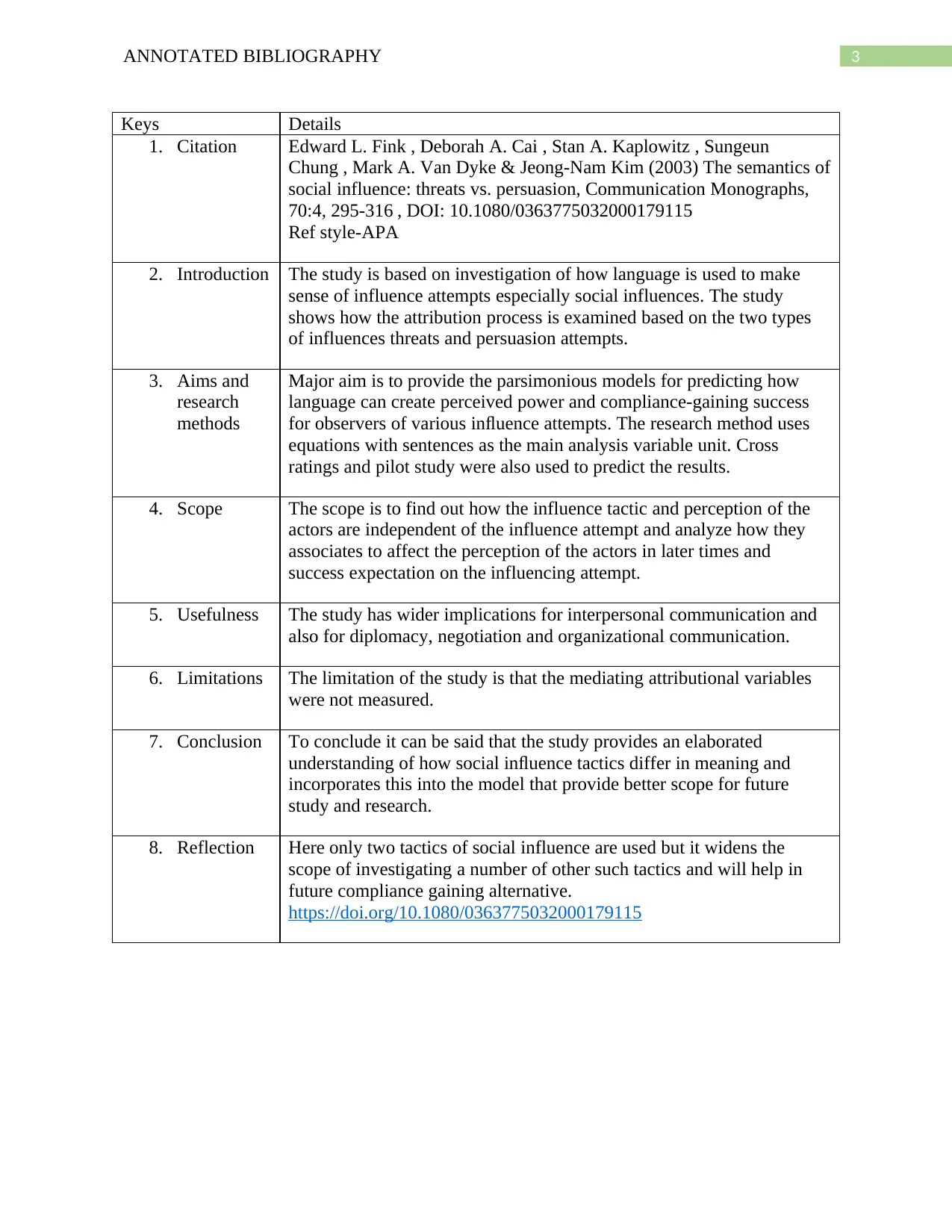
3ANNOTATED BIBLIOGRAPHY
Keys Details
1. Citation Edward L. Fink , Deborah A. Cai , Stan A. Kaplowitz , Sungeun
Chung , Mark A. Van Dyke & Jeong-Nam Kim (2003) The semantics of
social influence: threats vs. persuasion, Communication Monographs,
70:4, 295-316 , DOI: 10.1080/0363775032000179115
Ref style-APA
2. Introduction The study is based on investigation of how language is used to make
sense of influence attempts especially social influences. The study
shows how the attribution process is examined based on the two types
of influences threats and persuasion attempts.
3. Aims and
research
methods
Major aim is to provide the parsimonious models for predicting how
language can create perceived power and compliance-gaining success
for observers of various influence attempts. The research method uses
equations with sentences as the main analysis variable unit. Cross
ratings and pilot study were also used to predict the results.
4. Scope The scope is to find out how the influence tactic and perception of the
actors are independent of the influence attempt and analyze how they
associates to affect the perception of the actors in later times and
success expectation on the influencing attempt.
5. Usefulness The study has wider implications for interpersonal communication and
also for diplomacy, negotiation and organizational communication.
6. Limitations The limitation of the study is that the mediating attributional variables
were not measured.
7. Conclusion To conclude it can be said that the study provides an elaborated
understanding of how social influence tactics differ in meaning and
incorporates this into the model that provide better scope for future
study and research.
8. Reflection Here only two tactics of social influence are used but it widens the
scope of investigating a number of other such tactics and will help in
future compliance gaining alternative.
https://doi.org/10.1080/0363775032000179115
Keys Details
1. Citation Edward L. Fink , Deborah A. Cai , Stan A. Kaplowitz , Sungeun
Chung , Mark A. Van Dyke & Jeong-Nam Kim (2003) The semantics of
social influence: threats vs. persuasion, Communication Monographs,
70:4, 295-316 , DOI: 10.1080/0363775032000179115
Ref style-APA
2. Introduction The study is based on investigation of how language is used to make
sense of influence attempts especially social influences. The study
shows how the attribution process is examined based on the two types
of influences threats and persuasion attempts.
3. Aims and
research
methods
Major aim is to provide the parsimonious models for predicting how
language can create perceived power and compliance-gaining success
for observers of various influence attempts. The research method uses
equations with sentences as the main analysis variable unit. Cross
ratings and pilot study were also used to predict the results.
4. Scope The scope is to find out how the influence tactic and perception of the
actors are independent of the influence attempt and analyze how they
associates to affect the perception of the actors in later times and
success expectation on the influencing attempt.
5. Usefulness The study has wider implications for interpersonal communication and
also for diplomacy, negotiation and organizational communication.
6. Limitations The limitation of the study is that the mediating attributional variables
were not measured.
7. Conclusion To conclude it can be said that the study provides an elaborated
understanding of how social influence tactics differ in meaning and
incorporates this into the model that provide better scope for future
study and research.
8. Reflection Here only two tactics of social influence are used but it widens the
scope of investigating a number of other such tactics and will help in
future compliance gaining alternative.
https://doi.org/10.1080/0363775032000179115
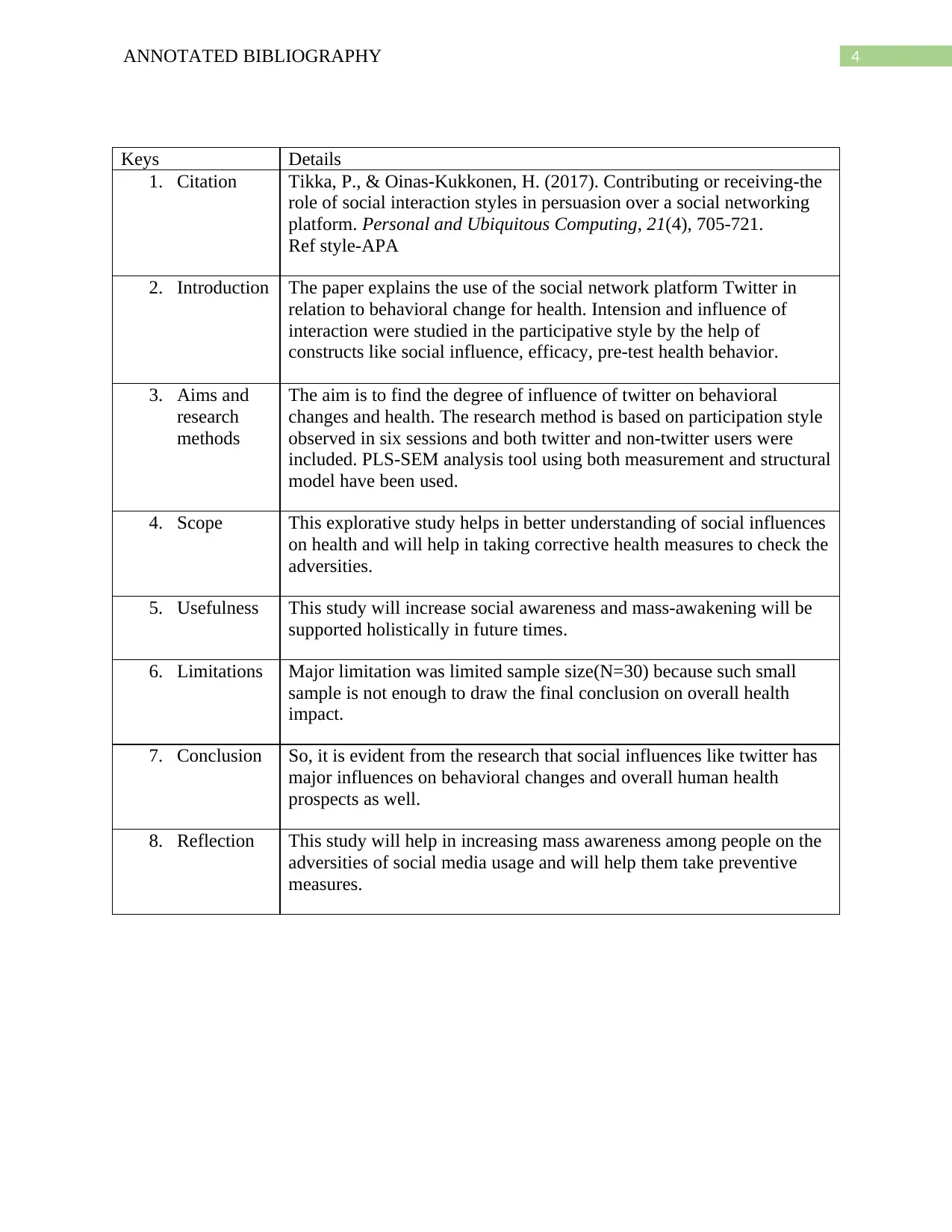
4ANNOTATED BIBLIOGRAPHY
Keys Details
1. Citation Tikka, P., & Oinas-Kukkonen, H. (2017). Contributing or receiving-the
role of social interaction styles in persuasion over a social networking
platform. Personal and Ubiquitous Computing, 21(4), 705-721.
Ref style-APA
2. Introduction The paper explains the use of the social network platform Twitter in
relation to behavioral change for health. Intension and influence of
interaction were studied in the participative style by the help of
constructs like social influence, efficacy, pre-test health behavior.
3. Aims and
research
methods
The aim is to find the degree of influence of twitter on behavioral
changes and health. The research method is based on participation style
observed in six sessions and both twitter and non-twitter users were
included. PLS-SEM analysis tool using both measurement and structural
model have been used.
4. Scope This explorative study helps in better understanding of social influences
on health and will help in taking corrective health measures to check the
adversities.
5. Usefulness This study will increase social awareness and mass-awakening will be
supported holistically in future times.
6. Limitations Major limitation was limited sample size(N=30) because such small
sample is not enough to draw the final conclusion on overall health
impact.
7. Conclusion So, it is evident from the research that social influences like twitter has
major influences on behavioral changes and overall human health
prospects as well.
8. Reflection This study will help in increasing mass awareness among people on the
adversities of social media usage and will help them take preventive
measures.
Keys Details
1. Citation Tikka, P., & Oinas-Kukkonen, H. (2017). Contributing or receiving-the
role of social interaction styles in persuasion over a social networking
platform. Personal and Ubiquitous Computing, 21(4), 705-721.
Ref style-APA
2. Introduction The paper explains the use of the social network platform Twitter in
relation to behavioral change for health. Intension and influence of
interaction were studied in the participative style by the help of
constructs like social influence, efficacy, pre-test health behavior.
3. Aims and
research
methods
The aim is to find the degree of influence of twitter on behavioral
changes and health. The research method is based on participation style
observed in six sessions and both twitter and non-twitter users were
included. PLS-SEM analysis tool using both measurement and structural
model have been used.
4. Scope This explorative study helps in better understanding of social influences
on health and will help in taking corrective health measures to check the
adversities.
5. Usefulness This study will increase social awareness and mass-awakening will be
supported holistically in future times.
6. Limitations Major limitation was limited sample size(N=30) because such small
sample is not enough to draw the final conclusion on overall health
impact.
7. Conclusion So, it is evident from the research that social influences like twitter has
major influences on behavioral changes and overall human health
prospects as well.
8. Reflection This study will help in increasing mass awareness among people on the
adversities of social media usage and will help them take preventive
measures.
Secure Best Marks with AI Grader
Need help grading? Try our AI Grader for instant feedback on your assignments.
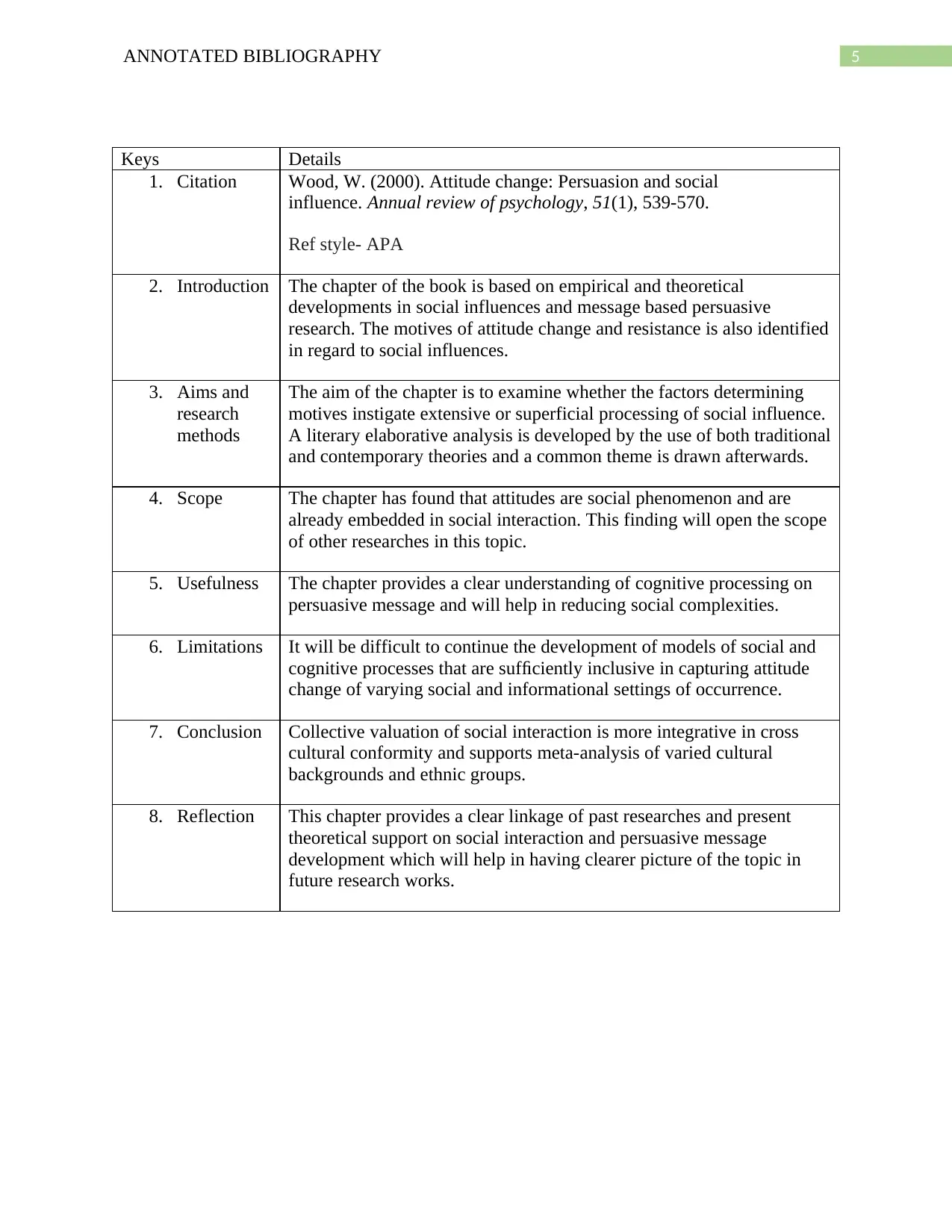
5ANNOTATED BIBLIOGRAPHY
Keys Details
1. Citation Wood, W. (2000). Attitude change: Persuasion and social
influence. Annual review of psychology, 51(1), 539-570.
Ref style- APA
2. Introduction The chapter of the book is based on empirical and theoretical
developments in social influences and message based persuasive
research. The motives of attitude change and resistance is also identified
in regard to social influences.
3. Aims and
research
methods
The aim of the chapter is to examine whether the factors determining
motives instigate extensive or superficial processing of social influence.
A literary elaborative analysis is developed by the use of both traditional
and contemporary theories and a common theme is drawn afterwards.
4. Scope The chapter has found that attitudes are social phenomenon and are
already embedded in social interaction. This finding will open the scope
of other researches in this topic.
5. Usefulness The chapter provides a clear understanding of cognitive processing on
persuasive message and will help in reducing social complexities.
6. Limitations It will be difficult to continue the development of models of social and
cognitive processes that are sufficiently inclusive in capturing attitude
change of varying social and informational settings of occurrence.
7. Conclusion Collective valuation of social interaction is more integrative in cross
cultural conformity and supports meta-analysis of varied cultural
backgrounds and ethnic groups.
8. Reflection This chapter provides a clear linkage of past researches and present
theoretical support on social interaction and persuasive message
development which will help in having clearer picture of the topic in
future research works.
Keys Details
1. Citation Wood, W. (2000). Attitude change: Persuasion and social
influence. Annual review of psychology, 51(1), 539-570.
Ref style- APA
2. Introduction The chapter of the book is based on empirical and theoretical
developments in social influences and message based persuasive
research. The motives of attitude change and resistance is also identified
in regard to social influences.
3. Aims and
research
methods
The aim of the chapter is to examine whether the factors determining
motives instigate extensive or superficial processing of social influence.
A literary elaborative analysis is developed by the use of both traditional
and contemporary theories and a common theme is drawn afterwards.
4. Scope The chapter has found that attitudes are social phenomenon and are
already embedded in social interaction. This finding will open the scope
of other researches in this topic.
5. Usefulness The chapter provides a clear understanding of cognitive processing on
persuasive message and will help in reducing social complexities.
6. Limitations It will be difficult to continue the development of models of social and
cognitive processes that are sufficiently inclusive in capturing attitude
change of varying social and informational settings of occurrence.
7. Conclusion Collective valuation of social interaction is more integrative in cross
cultural conformity and supports meta-analysis of varied cultural
backgrounds and ethnic groups.
8. Reflection This chapter provides a clear linkage of past researches and present
theoretical support on social interaction and persuasive message
development which will help in having clearer picture of the topic in
future research works.
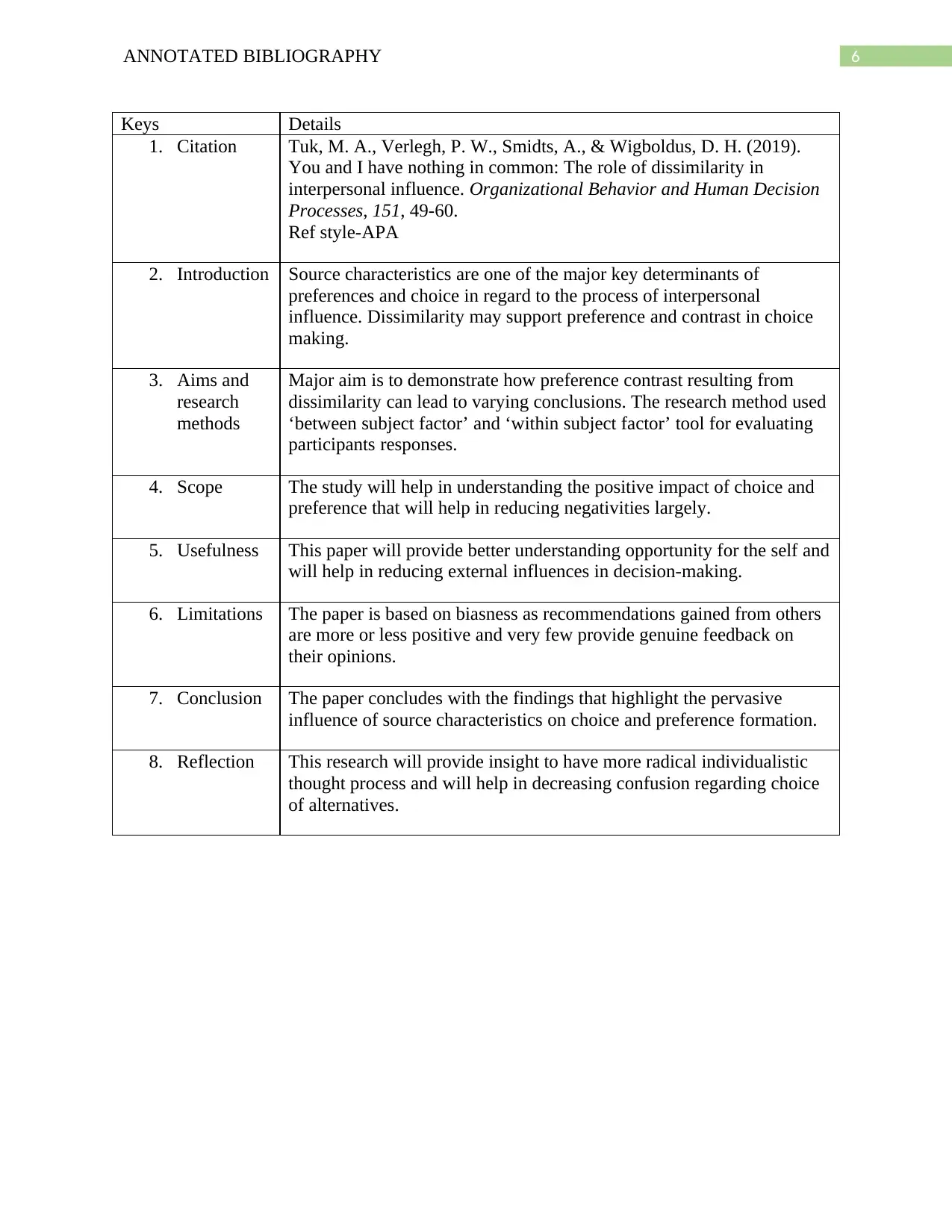
6ANNOTATED BIBLIOGRAPHY
Keys Details
1. Citation Tuk, M. A., Verlegh, P. W., Smidts, A., & Wigboldus, D. H. (2019).
You and I have nothing in common: The role of dissimilarity in
interpersonal influence. Organizational Behavior and Human Decision
Processes, 151, 49-60.
Ref style-APA
2. Introduction Source characteristics are one of the major key determinants of
preferences and choice in regard to the process of interpersonal
influence. Dissimilarity may support preference and contrast in choice
making.
3. Aims and
research
methods
Major aim is to demonstrate how preference contrast resulting from
dissimilarity can lead to varying conclusions. The research method used
‘between subject factor’ and ‘within subject factor’ tool for evaluating
participants responses.
4. Scope The study will help in understanding the positive impact of choice and
preference that will help in reducing negativities largely.
5. Usefulness This paper will provide better understanding opportunity for the self and
will help in reducing external influences in decision-making.
6. Limitations The paper is based on biasness as recommendations gained from others
are more or less positive and very few provide genuine feedback on
their opinions.
7. Conclusion The paper concludes with the findings that highlight the pervasive
influence of source characteristics on choice and preference formation.
8. Reflection This research will provide insight to have more radical individualistic
thought process and will help in decreasing confusion regarding choice
of alternatives.
Keys Details
1. Citation Tuk, M. A., Verlegh, P. W., Smidts, A., & Wigboldus, D. H. (2019).
You and I have nothing in common: The role of dissimilarity in
interpersonal influence. Organizational Behavior and Human Decision
Processes, 151, 49-60.
Ref style-APA
2. Introduction Source characteristics are one of the major key determinants of
preferences and choice in regard to the process of interpersonal
influence. Dissimilarity may support preference and contrast in choice
making.
3. Aims and
research
methods
Major aim is to demonstrate how preference contrast resulting from
dissimilarity can lead to varying conclusions. The research method used
‘between subject factor’ and ‘within subject factor’ tool for evaluating
participants responses.
4. Scope The study will help in understanding the positive impact of choice and
preference that will help in reducing negativities largely.
5. Usefulness This paper will provide better understanding opportunity for the self and
will help in reducing external influences in decision-making.
6. Limitations The paper is based on biasness as recommendations gained from others
are more or less positive and very few provide genuine feedback on
their opinions.
7. Conclusion The paper concludes with the findings that highlight the pervasive
influence of source characteristics on choice and preference formation.
8. Reflection This research will provide insight to have more radical individualistic
thought process and will help in decreasing confusion regarding choice
of alternatives.
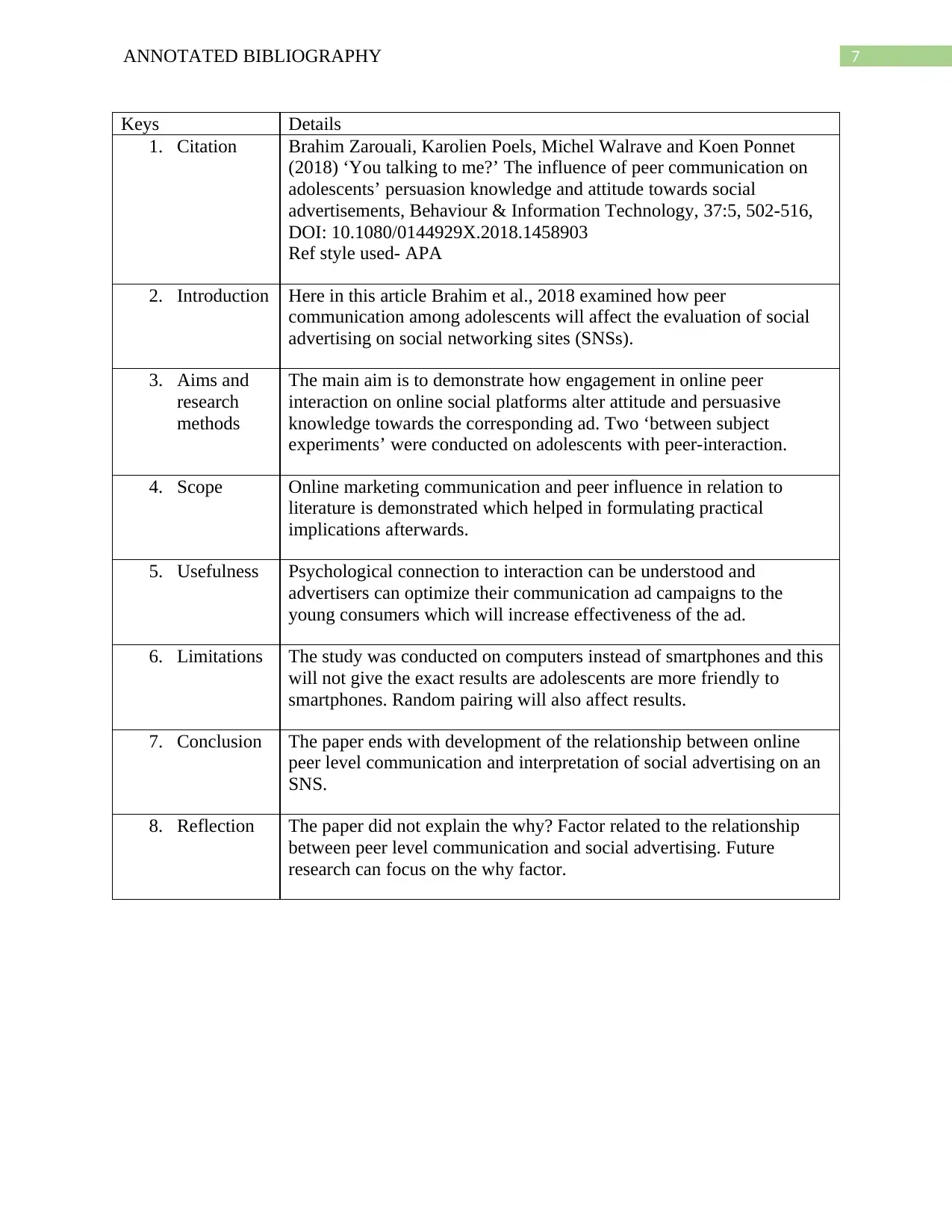
7ANNOTATED BIBLIOGRAPHY
Keys Details
1. Citation Brahim Zarouali, Karolien Poels, Michel Walrave and Koen Ponnet
(2018) ‘You talking to me?’ The influence of peer communication on
adolescents’ persuasion knowledge and attitude towards social
advertisements, Behaviour & Information Technology, 37:5, 502-516,
DOI: 10.1080/0144929X.2018.1458903
Ref style used- APA
2. Introduction Here in this article Brahim et al., 2018 examined how peer
communication among adolescents will affect the evaluation of social
advertising on social networking sites (SNSs).
3. Aims and
research
methods
The main aim is to demonstrate how engagement in online peer
interaction on online social platforms alter attitude and persuasive
knowledge towards the corresponding ad. Two ‘between subject
experiments’ were conducted on adolescents with peer-interaction.
4. Scope Online marketing communication and peer influence in relation to
literature is demonstrated which helped in formulating practical
implications afterwards.
5. Usefulness Psychological connection to interaction can be understood and
advertisers can optimize their communication ad campaigns to the
young consumers which will increase effectiveness of the ad.
6. Limitations The study was conducted on computers instead of smartphones and this
will not give the exact results are adolescents are more friendly to
smartphones. Random pairing will also affect results.
7. Conclusion The paper ends with development of the relationship between online
peer level communication and interpretation of social advertising on an
SNS.
8. Reflection The paper did not explain the why? Factor related to the relationship
between peer level communication and social advertising. Future
research can focus on the why factor.
Keys Details
1. Citation Brahim Zarouali, Karolien Poels, Michel Walrave and Koen Ponnet
(2018) ‘You talking to me?’ The influence of peer communication on
adolescents’ persuasion knowledge and attitude towards social
advertisements, Behaviour & Information Technology, 37:5, 502-516,
DOI: 10.1080/0144929X.2018.1458903
Ref style used- APA
2. Introduction Here in this article Brahim et al., 2018 examined how peer
communication among adolescents will affect the evaluation of social
advertising on social networking sites (SNSs).
3. Aims and
research
methods
The main aim is to demonstrate how engagement in online peer
interaction on online social platforms alter attitude and persuasive
knowledge towards the corresponding ad. Two ‘between subject
experiments’ were conducted on adolescents with peer-interaction.
4. Scope Online marketing communication and peer influence in relation to
literature is demonstrated which helped in formulating practical
implications afterwards.
5. Usefulness Psychological connection to interaction can be understood and
advertisers can optimize their communication ad campaigns to the
young consumers which will increase effectiveness of the ad.
6. Limitations The study was conducted on computers instead of smartphones and this
will not give the exact results are adolescents are more friendly to
smartphones. Random pairing will also affect results.
7. Conclusion The paper ends with development of the relationship between online
peer level communication and interpretation of social advertising on an
SNS.
8. Reflection The paper did not explain the why? Factor related to the relationship
between peer level communication and social advertising. Future
research can focus on the why factor.
1 out of 7
Your All-in-One AI-Powered Toolkit for Academic Success.
+13062052269
info@desklib.com
Available 24*7 on WhatsApp / Email
![[object Object]](/_next/static/media/star-bottom.7253800d.svg)
Unlock your academic potential
© 2024 | Zucol Services PVT LTD | All rights reserved.

